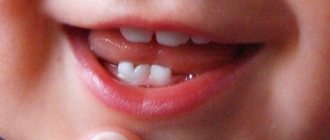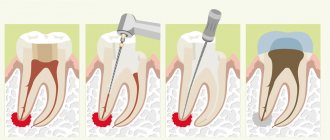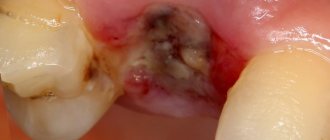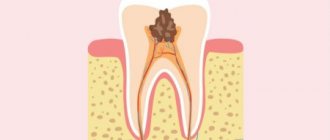Home / Articles / Teeth falling out - what to do
The absence of a tooth, especially the front one, always provokes a lot of problems. The main one is a decrease in a person’s self-esteem, because in the absence of a beautiful smile, everyone will avoid communication. At the same time, tooth loss can be accompanied by numerous physiological problems. The contours of the face may noticeably change, and insufficient chewing of food can even provoke disturbances in the functioning of the stomach, although even this is not the worst consequence.
Sign up for a free consultation >>
Why do teeth fall out
If your teeth begin to fall out, think about the reason for their loss. There are several common reasons why teeth fall out in humans:
Caries
Caries disease is accompanied by a violation of the mineralization of teeth, which ultimately destroys bone tissue in the oral cavity. Inside the tooth, the cavity gradually grows and becomes empty, which leads to acute sensitivity and food particles getting inside the teeth. Ignoring the symptoms of caries and unwillingness to consult a professional dentist ultimately leads to the fact that the tooth completely ceases to perform its function. The only solution in this case is to pull out the tooth.
It is possible to avoid caries by brushing your teeth properly and using toothpaste rich in fluoride. If even small holes appear in the teeth, it is recommended to immediately fill them in a specialized clinic.
Periodontitis
The first symptoms of the disease are bleeding in the gums. Next, an unpleasant odor appears in the oral cavity and a purulent process begins when pressure is applied to the gums. After some time, the affected tissues become completely incapacitated. Therefore, if your tooth falls out with blood, often the reason lies precisely in periodontitis.
Prevention of the disease in this case is quite simple: monitor the health of your gums and always visit the dentist in a timely manner, without waiting until the pathology becomes incurable. After each meal, try to brush your teeth for three minutes using special dental floss and toothpaste.
Chronic diseases
The reason why teeth fall out without pain and blood, and sometimes with them, can also be inflammatory processes as a result of chronic diseases. Common causes are hypertension, thyroid problems, diabetes, and respiratory problems. Often, aggressive methods of treating serious diseases, in particular chemotherapy, can provoke dental problems.
Negligent oral care, improper diet
It's no secret that citrus drinks can deplete enamel, which causes erosion. Gradually, this stimulates the development of caries and leads to the final loss of the tooth. A similar effect can occur if you carelessly eat nuts, crackers and other hard items. Clefts appear in the teeth, they become loose and subsequently fall out. Try to avoid eating excessively hot and cold foods.
Tobacco products, drugs
About a third of patients who systematically lose teeth are people with bad habits, in particular, heavy smokers. It is reliably known that drugs and tobacco not only worsen the color of teeth, but can also be the reason why molars fall out.
Recommendations for everyone
Are there any general recommendations that are effective in all cases?
Yes, I have. The first and most important thing is not to panic. Usually, tooth loss is accompanied by panic and surprise. Especially if an unpleasant event occurred during a meal or during another event, when nothing foreshadowed trouble.
When panicking, a person makes mistakes that will still have to be corrected later. Therefore, the first and most important recommendation is not to panic.
The second recommendation is to trust dentists. It is better not to self-medicate, but to turn to specialists. Let them examine, make a diagnosis, and do everything necessary to keep your mouth healthy. After all, health is not something that can be entrusted to amateurs, not professionals.
Otherwise, healthy teeth and may none of the readers ever need dental services.
Why teeth fall out in adults and children.
Tooth loss is a bad sign that most often causes anxiety in people. The problem is, of course, serious, but it also has various solutions.
Tooth loss in children
When (at what age) do baby teeth fall out? Typically, the first milk teeth fall out in children aged 6-7 years, but deviations from the timing are possible based on the individual characteristics of the body. Although baby teeth erupt at the age of 6 months, their formation begins in the uterine period during the mother’s pregnancy. With the birth of a child, the formation of the rudiments of permanent teeth begins, which is why it is important to monitor the health of the milk teeth, because infection with caries can easily harm the rudiments of permanent teeth.
A longitudinal (vertical) crack appeared on the tooth
Shallow cracks along the tooth that do not extend under the gums are eliminated with a composite material and subsequent installation of veneers. Thin overlays mask the aesthetic defect and strengthen the crown, preventing its further destruction. Molars experience increased chewing load, so cracks on them require the use of ceramic/zirconium crowns.
A deep vertical crack often leads to pulpitis. In this case, it is necessary to remove the nerve and carry out a step-by-step reconstruction of the tooth (filling, veneer or crown).
With a strong impact, a vertical crack extends to the root of the tooth. It is possible to restore a tooth if the root is at least one third intact, and the patient immediately seeks help. An attempt to save a dead tooth in this way with partial damage to a single root (incisors, canines and sometimes premolars) often leads to the gradual destruction of the entire root system. In such cases, the only correct option is tooth extraction and subsequent prosthetics/implantation.
Important! Since a pulpless tooth does not receive nutrition, the enamel quickly loses its strength. Therefore, it is advisable to install a crown on a cracked tooth without a nerve (the root is not damaged).
Horizontal tooth crack
A crack surrounding a tooth often does not affect the pulp, so the nerve can be preserved. Tooth restoration includes the use of a composite and restoration with crowns or veneers (front only). Without timely treatment, a transverse crack leads to partial chipping of the tooth. The dentist builds up the broken area with a composite material.
A high risk of tooth loss is caused by a horizontal crack formed at the gum line. In this place the tooth is most vulnerable; the crown can completely (or most of it) break off even from a small load. In fact, the tooth is lost, but it is quite possible to restore it using extensions on pins and restoration using a ceramic crown.
Important! If, after an impact and complete loss of the crown, the roots of the tooth become very loose, there is no point in restoring the tooth. Gradually it will fall out along with the unstable roots.
Tooth root crack
The defect is formed from the root to the edge of the tooth and is diagnosed only on an x-ray. With internal chipping, the risk of soft tissue necrosis and jaw fracture increases. If the crack damaged only one tooth root, partial preservation of the natural crown is possible. Part of the damaged tooth is removed and then built up using pins and composite. In this case, it is advisable to create additional protection and install a metal-ceramic crown. Removal cannot be avoided if the only tooth root is cracked.
Tooth cracked in half
With this type of damage, both walls of the tooth are most often affected. Even the slightest load causes severe pain. Treatment depends on the degree of damage to the root part. If a tooth is cracked diagonally and a large fragment is loose, the unstable part is removed and the crown is restored. In cases where the tooth is cracked in half to the root (gum level), and its parts remain stable, treatment is carried out according to the standard algorithm (composite, veneer or crown). Looseness of both parts of a split tooth indicates destruction of the root along its entire length. In such a situation, careful tooth extraction is performed.
Important! A tooth that is cracked in half can break at any time.
A child's baby tooth is cracked
Most often, defects in baby teeth are caused by feeding with cow's milk (calcium is poorly absorbed) and excessive consumption of sweets. The dentist will grind down the chewing cusps. This reduces the load and removes the damaged tooth from the chewing process. If the child is left untreated, the fragments will cause gum inflammation and may damage the emerging permanent teeth.
Important! Deep cracks in permanent teeth in children require endodontic treatment (nerve removal) followed by filling. However, such a procedure does not exclude tooth destruction in the future.
A pregnant woman's tooth cracked
Damage to tooth enamel is an entry point for infection. Therefore, any dental problems for expectant mothers must be treated in the second trimester of pregnancy. A cracked tooth is no exception. If a split appears on a previously treated tooth, first replace the failing filling and repair the crack with a composite material, then install a crown. A temporary filling is not advisable in this case. Treatment of cracked teeth in pregnant women is carried out according to the usual algorithm for adult patients, with the exception of implantation.
Important! To treat a cracked tooth in a pregnant woman, anesthetics that are safe for the unborn child are used.
Cracked wisdom tooth
Wisdom teeth are more exposed to an acidic environment, and therefore cracks, chips and caries often appear on them. These crowns do not participate in the chewing process and are difficult to access for quality treatment. Therefore, when cracks appear, experts recommend removing wisdom teeth.
To avoid losing a cracked tooth, make an appointment with your dentist as soon as the damage is discovered and use only experienced dentists. The high level of the clinic is evidenced by the certificates of doctors and customer reviews. Matisse Dent specialists use modern methods of treating cracked teeth and will do everything to save your tooth.
Do teeth fall out on their own?
Yes, they fall out if they are dairy. In this case, changing teeth can be accompanied in children by acute painful sensations, swelling of the gums and sensitivity of the enamel, and in some cases even itching. If you experience these symptoms, it is important to seek the advice of a professional dentist. At the same time, while waiting to see which tooth falls out first, you should not forget about the child’s adequate nutrition so that the body and teeth in particular continue to receive all the necessary vitamins and microelements.
When a baby tooth falls out, the wound may continue to bleed for 5-10 minutes. Simply give your child a sterile gauze or cotton swab to bite on the area where the baby tooth has fallen out. If bleeding continues for a long time, be sure to take your baby to the pediatrician to check blood clotting. The help of a dentist may also be needed when baby teeth complicate the eruption of permanent teeth. In this case, the teeth are forcibly removed.
Causes of dental injuries
Most often, dental damage occurs at one moment, for example, during an accident, a fall, a strong blow to the jaw, or performing a sports exercise. Sometimes a tooth shifts gradually if a future dental patient periodically chews hard objects, nails, or tears threads with his teeth. As a result of such manipulations, tooth enamel is gradually worn away and chips appear. Subsequently, the tooth may crumble during ordinary activities, such as brushing or chewing food.
In good dentistry, treatment procedures are always successful, in compliance with all rules. However, if you decide to take a risk and save money, the tooth may be destroyed if the operation is unsuccessful. For example, dislocation can occur due to inaccurate removal of nearby teeth. Injuries are also common when installing orthodontic appliances.
What to do if teeth fall out
Many patients are interested in the question of what to do if a tooth falls out at home. Of course, in a number of such cases no additional measures are required - for example, if a tooth falls out in the side of the jaw, which is not visible when communicating with other people. However, the need to restore a lost tooth may not only become necessary if the tooth falls out from the front. Since the load on the jaw is unevenly distributed, this can ultimately lead to jawbone atrophy. The only way out of the current conditions is to install a dental implant.
If a patient has lost a front tooth, or if it was deliberately removed, it is possible to restore a beautiful smile with the help of a bridge. A similar solution is appropriate if the permanent lower tooth falls out, which is subject to the greatest load when eating food. The use of a bridge is also appropriate if false teeth, rather than permanent ones, have fallen out.
Diagnostics
Diagnosis begins with collecting anamnesis. The presence of trauma speaks in favor of a fracture. It is important to establish the nature and direction of action of the damaging factor, since changes in the oral cavity may not be isolated.
The patient's complaints are specific: pain, bleeding, swelling, mobility, inability to open the mouth. After identifying the circumstances of the injury and complaints, the dentist proceeds to examine the oral cavity. Injuries visible to the naked eye are not difficult to diagnose; root fractures require a more in-depth examination and additional examination methods.
X-rays help get as much information as possible. The image will show the size, location, and nature of the damage. This method reveals minor chips and cracks. It is the image that allows the doctor to make a decision on preservation or removal and to develop further treatment tactics.
Why does a filling fall out?
Filling loss is an equally common problem with the human oral cavity. This also creates an uncomfortable feeling, especially when eating: the chewing process becomes more difficult, and pain symptoms begin. If a filling has fallen out of your tooth, be sure to seek help from a professional dentist in your city.
There are a wide variety of reasons why a filling may suddenly fall out of a tooth. The most common among them is the use of low-quality materials in the filling, as well as improper shrinkage of the filling inside the tooth . This can cause a small hole to form between the tooth and the filling, which becomes clogged with food and becomes a breeding ground for bacteria. Often this situation is complicated by the appearance of secondary caries.
Often the loss of a filling is associated with the expiration of its service life . On average, based on installation technology and manufacturing material, a filling lasts about 7 years. Regular visits to the dental clinic will help determine when the need to replace the filling arises.
Other reasons why fillings may fall out are a lot of pressure on the tooth (in particular, due to strong impacts or cracking of a nut), as well as failure to maintain proper oral hygiene.
Lack of prevention?
There is a sign: a lost tooth attracts wealth.
This concept probably dates back to childhood, when parents gave chocolates or something tasty for a lost baby tooth. Unfortunately, usually if teeth fall out on their own, this probably indicates poor oral care. This could be expressed, for example, like this:
- Brushing your teeth not every day
.
Dental statistics are terrifying: almost half of the country's population neglects daily brushing or brushes their teeth once a day. In the long term, this can lead to serious oral diseases. In extreme cases, it will be necessary to remove damaged teeth that cannot be restored, but infect neighboring ones. - Lack of
mouth rinsing after meals. The idea of the need to rinse your mouth every day after eating is still not widespread among Russians, and this is causing an increase in dental diseases. - Lack of calcium-rich foods. Calcium is the main source of strong and healthy teeth. She cannot be neglected. Teeth often become loose and fall out precisely because of a lack of calcium in the body.
What to do in these cases? First of all, resume daily oral hygiene and switch to a healthy diet. Sometimes, if the disease is not too advanced, this can help. However, you shouldn’t count on this too much and if your teeth continue to bother you, you should consult a doctor.
What to do if a filling falls out
Losing a filling is a common problem, but does not have any negative consequences other than the pain associated with the reopened nerve. If a temporary filling falls out at the most inopportune moment, try to contact your dentist as soon as possible. Given that the tooth cavity is opening up again, delaying the process of installing another filling can lead to aggravation of the problem, especially if food particles get into the tooth cavity.
Before starting treatment for a temporary filling that falls out, dentists determine the reason for the loss. Based on specific conditions, a certain material is selected, and treatment occurs using a certain technology. During the treatment, the remains of the previous filling are eliminated, the oral cavity is thoroughly processed, and then the damaged tooth is restored.
Until the dentist restores the lost filling and numbs the pain, the only possible measure the patient can take is not to place excessive stress on the damaged tooth. It is advisable to chew food on the other side of the jaw, and when brushing your teeth, treat the damaged area more carefully. It is also recommended to rinse your mouth more often to protect the damaged tooth from possible penetration of food debris with microbes and bacteria into it.
Statistics confirm that about 39% of people who complain about dental problems try to avoid visiting doctors. Fear of instruments and drills is quite justified, as is fear of possible discomfort when treating teeth and gums. However, it is precisely those patients who undergo systematic examination by dentists who avoid the biggest troubles throughout their lives. These include tooth loss.
Sign up for a free consultation >>
View prices
Making an appointment with a dentist
Physical effects
It happens that after a fight, a tooth falls out by the root. If this happens, you should not only consult a doctor, but also use the previous recommendations. After all, if a tooth falls out due to a blow, it means that it didn’t hold on well before.
Other influences also affect teeth. For example:
- Smoking
. If a smoker notices the appearance of serious problems with his teeth, this is a reason to seriously think about his health and quit smoking. Cigarettes have an extremely harmful effect on teeth and, sometimes, it is enough to get rid of the bad habit for oral problems to disappear. - Coffee
. Another food enemy of dental health. Excessive coffee consumption not only removes the natural whiteness of teeth, but can lead to other, more serious diseases. The fact is that coffee flushes calcium from the body, and it, in turn, directly affects the health and strength of teeth. Do you drink a lot of coffee? Increase your diet with foods high in calcium. - Quality of water and food
.
Remember how, as a child, you were warned not to drink tap water? Bad water, rich in harmful substances, can sometimes corrode the tooth, and in the case of a genetic predisposition, even lead to tooth loss.
What to do in these and other similar cases?
First of all, limit the harmful effects on the teeth. Stop smoking, drinking too much coffee and start boiling your drinking water. Such reasons are easily removed, since the presence or absence of harmful factors depends solely on the individual person.
However, the tooth is most likely damaged. Therefore, it is recommended to contact the Dental Clinic “Doctor-RAF” (Almaty, Muratbayev St., 101) for a FREE consultation - an initial appointment with a dentist, and, if necessary, for a repeat appointment.
What are they?
Fused teeth are a rare pathology characterized by the fusion of the sides of the rudiments during the embryonic development of the fetus. This anomaly occurs in only 1% of the population.
Most often, this disease is observed during the period of primary occlusion . Permanent teeth are affected 5 times less often.
The reasons that provoke the development of pathology following :
- excessive pressure on the buds of adjacent teeth;
- injuries of various types;
- heredity;
- metabolic disorders caused by various inflammatory or infectious diseases.
In addition, the fusion can form in the presence of osteoporosis, dysplasia or hypoplasia.
Read how you can close diastemas in a new publication.
In a separate article we will tell you which pathologies are characterized by spiky teeth.
Follow the link https://orto-info.ru/zubocheliustnye-anomalii/okklyuzii/nepravilnyiy-prikus-zubov-kakie-mogut-byt-posledstvija.html let's talk about possible complications of malocclusion.
The main symptom of the anomaly is considered to be an overly large tooth, whose height is several times less than the length of the cutting surface . As a result, it often has an irregular shape and position.
Characterized by being rotated around its axis or located on adjacent ones.
The abnormal tooth has a longitudinal groove marking the fusion boundary. It starts from the gum line and can cross the entire height of the outer part, or only reach half of it.
What is the difference between fusion and fusion?
This anomaly is often confused with fusion, but in fact fusion and fusion are completely different pathologies :
- Fusion. It is a connection of two teeth in the area of cement, which is formed after the completion of their development and growth.
Most often it is provoked by crowding of the dentition or a violation of the integrity of the partitions of the alveolar ridge. Fusion can occur between both normal and supernumerary specimens.Typically, this pathology affects the molars of the upper jaw.
- Merger is formed at the rudimentary level. In this case, the area of connection is dentin, and in isolated cases, enamel.
The main area of localization is the incisors of the upper jaw. Most often, fusion leads to a decrease in the total number of teeth on the jaw arch.In rare cases, the anomaly combines regular and supernumerary teeth.
Possible consequences
Incorrect development of even one tooth can have very serious negative consequences , among which the following were most often noted:
- formation of malocclusion;
- dysfunction of biting and chewing food;
- with excessive increase, mouth breathing can form, which leads to frequent ENT inflammations;
- dysfunction of the gastrointestinal tract, which develops as a result of increased load on them due to poorly chewed food;
- speech changes: lisp, unclear pronunciation of sounds, swallowing them;
- psychological trauma;
In addition, when removing the affected part of an abnormal tooth, there is a high risk of dislocation of a healthy one.
Classification
Based on the identified clinical picture and x-ray examination, several types of pathology were identified .
Type I
The first type is characterized by supernumerary fusion, in which the second tooth is smaller . It is distinguished by its spiky shape and bumpy surface.
Most often, supernumerary specimens act as the second part.
Type II
This type is different in that fusion occurs only in the supragingival region, involving the enamel and a minimal layer of dentin.
III type
of fusion occurs at the root level in the area of the cementum . As a rule, in this case, the teeth are connected with deep damage to the dentin.
Moreover, both parts have the same shape and, practically, the same dimensions. The only difference can be in the length of the cutting part. The complementary part is already the main one.
IV type
The fourth stage is characterized by the fusion of dental tissues throughout the entire height of the tooth . Both the coronal and root parts are involved in the joining process.
In this case, the pulp chambers can be separated or merge into one cavity.










